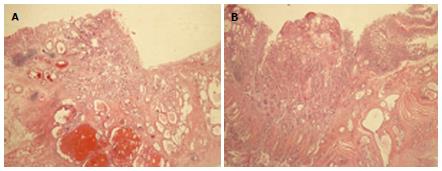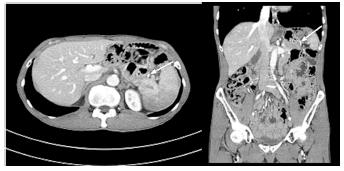Published online Apr 27, 2014. doi: 10.4240/wjgs.v6.i4.74
Revised: January 16, 2014
Accepted: February 18, 2014
Published online: April 27, 2014
Processing time: 273 Days and 23.4 Hours
This is a very rare case of the recurrence of gastric cancer in the jejunal stump after radical total gastrectomy with Roux-en-Y reconstruction. In January 2008, a 65-year-old man underwent radical total gastrectomy with Roux-en-Y reconstruction for stage IB gastric cancer of the upper body. At a follow-up in December 2011, the patient had a recurrence of gastric cancer on gastroduodenal fibroscopy. The gastroduodenal fibroscopic biopsy specimens show a well-differentiated tubular adenocarcinoma. Computed tomography showed no lymphadenopathy or hepatic metastases. At laparotomy, there was a tumor in the jejunal stump involving the pancreatic tail and spleen. Therefore, the patient underwent jejunal pouch resection, distal pancreatectomy and splenectomy. The patient was diagnosed with gastric cancer on histopathological examination.
Core tip: In our study, there was a case of recurrence of gastric cancer in the jejunal stump after radical total gastrectomy with Roux-en-Y reconstruction. The patient underwent jejunal pouch resection, distal pancreatectomy and splenectomy. On histopathologic examinations, the patient was diagnosed with gastric cancer.
- Citation: Yoo JH, Seo SH, An MS, Ha TK, Kim KH, Bae KB, Choi CS, Oh SH, Choi YK. Recurrence of gastric cancer in the jejunal stump after radical total gastrectomy. World J Gastrointest Surg 2014; 6(4): 74-76
- URL: https://www.wjgnet.com/1948-9366/full/v6/i4/74.htm
- DOI: https://dx.doi.org/10.4240/wjgs.v6.i4.74
Gastric cancer is a highly prevalent cancer that occurs the most commonly in Korea. It shows a very good prognosis when detected earlier in a regular medical check-up. In advanced cancer, however, a poor prognosis has been well documented. There are many recurrent cases of gastric cancer despite radical surgery. Its recurrence occurs through hematogenous, peritoneal dissemination or via the lymph nodes. We report a case of recurrence of gastric cancer in the jejunal stump after radical total gastrectomy with Roux-en-Y reconstruction.
A 65-year-old man presented with a recurrence on gastroduodenal fibroscopy (Figure 1) at a follow-up after gastric cancer surgery. He underwent radical total gastrectomy with Roux-en-Y reconstruction (end to side esophagojejunostomy with circular stapler), for gastric cancer detected on gastroduodenal fibroscopy in January 2008. The gastric cancer had a tumor node metastasis stage of IB (T2N0M0), which had lesions of 2.5 cm × 2.0 cm in size on the posterior wall of the upper part of the gastric fundus. Based on histopathology, findings were suggestive of well-differentiated tubular adenocarcinoma. There was no lymph node metastasis or metastasis to other organs in the abdomen (Figure 2). Postoperatively, the patient underwent an uneventful course without notable episodes and achieved a recovery. The patient had been taking oral chemotherapeutic drugs (5-fluorouracil) during a period ranging from January 2008 to December 2009. Following this, the patient had no recurrence and had an outpatient follow-up. Meanwhile, in December 2011, the patient had a single small polypoid infiltrative ill-defined mass of approximately 1.2 cm in size at the site approximately 3 cm from the distal part of the esophagojejunal junction to the blind loop (the posterior wall of the jejunal stump) on gastroduodenal fibroscopy (Figure 1). The patient therefore underwent histopathological examinations, presenting with findings suggestive of well-differentiated tubular adenocarcinoma. Therefore, the patient was admitted for further evaluation and treatment. At the time of admission, the patient had a good systemic and nutritional status with stable vital signs. On examination, the patient had no palpable left supraclavicular lymph nodes. On abdominal examination, the patient had no tenderness, shifting dullness or palpable abdominal masses. In addition, the patient also had no positive findings on rectal examination. The patient underwent clinical laboratory tests for hemoglobin, white blood cell counts, platelet counts, serum electrolytes, serum biochemistry, urinalysis, serological tests and blood coagulation tests, all of which were normal. Serum levels of carcinoembryonic antigen, a tumor marker, were 4.95 ng/mL. Abdominal computed tomography (CT) showed no recurrence and metastasis, which is also consistent with previous abdominal CT scans (Figure 3). Under general anesthesia, the patient underwent surgery for jejunal stump resection, distal pancreatectomy with splenectomy in January 2012. Intraoperatively, the patient presented with a tumor in the jejunum and invasion to the pancreatic tail and the spleen, with no evidence of hepatic or peritoneal recurrence, for which the patient underwent dissection of the jejunal stump, the pancreatic tail and the spleen. The postoperative course was uneventful. On histopathological examination, there was a recurrence of the gastric cancer in the jejunal pouch, the pancreatic tail and the spleen. Currently, the patient is receiving an injection of chemotherapy regimens (FOLFOX chemotherapy).
The local recurrence of gastric cancer after total gastrectomy mostly occurs in the proximal region from the esophagojejunal junction. Anastomotic or suture-line recurrence after gastrectomy is reported to be 3%-10%[1]. Recurrence in the distal jejunal stump is a rare entity. The main theory of the cause and mechanisms of recurrence includes submucosal or subserosal lymphatic spread of cancer, the remainder of the stump and the implantation of exfoliated cancer cells[1-3]. In this case, histological study revealed no lymph node metastasis and no vessel permeation. Both resection margins were also negative for cancer cells. For this reason, the theory of lymphatic spread of cancer and the remainder of the stump can be rejected. The implantation of exfoliated cancer cells may be the reason for recurrence but it is unclear. The recurrence of the anastomosis or suture-line is rare and its mechanism is unclear but local recurrence can be treated by surgery. So, an early diagnosis of local recurrence can improve the prognosis. Gastroduodenal fibroscopy can be useful to detect an intraluminal recurrence. CT or positron emission tomography (PET) can detect gastric bed or regional lymph nodes. We recommend that routine outpatient follow-up includes gastroduodenal fibroscopy, CT and PET.
A 65-year-old man presented with gastric cancer recurrence, as shown on gastroduodenal fibroscopy.
Histopathological examination revealed a diagnosis of gastric cancer.
Gastroduodenal fibroscopy, computed tomography and positron emission tomography.
Yoo JH et al described a rare case of recurrence of gastric cancer in the jejunal pouch after radical total gastrectomy with Roux-en-Y reconstruction. This is an interesting case.
P- Reviewer: Hamai Y S- Editor: Wen LL L- Editor: Roemmele A E- Editor: Wu HL
| 1. | Papachristou DN, Karas M, Fortner JG. Anastomotic recurrence in the oesophagus complicating gastrectomy for adenocarcinoma of the stomach. Br J Surg. 1979;66:609-612. [RCA] [PubMed] [DOI] [Full Text] [Cited by in Crossref: 25] [Cited by in RCA: 27] [Article Influence: 0.6] [Reference Citation Analysis (0)] |
| 2. | Namikawa T, Kobayashi M, Okamoto K, Okabayashi T, Akimori T, Sugimoto T, Hanazaki K. Recurrence of gastric cancer in the jejunal pouch after completion gastrectomy. Gastric Cancer. 2007;10:256-259. [RCA] [PubMed] [DOI] [Full Text] [Cited by in Crossref: 15] [Cited by in RCA: 13] [Article Influence: 0.7] [Reference Citation Analysis (0)] |
| 3. | Nishimura M, Honda I, Watanabe S, Nagata M, Souda H, Miyazaki M. Recurrence in jejunal pouch after proximal gastrectomy for early upper gastric cancer. Gastric Cancer. 2003;6:197-201. [RCA] [PubMed] [DOI] [Full Text] [Cited by in Crossref: 19] [Cited by in RCA: 17] [Article Influence: 0.8] [Reference Citation Analysis (0)] |











